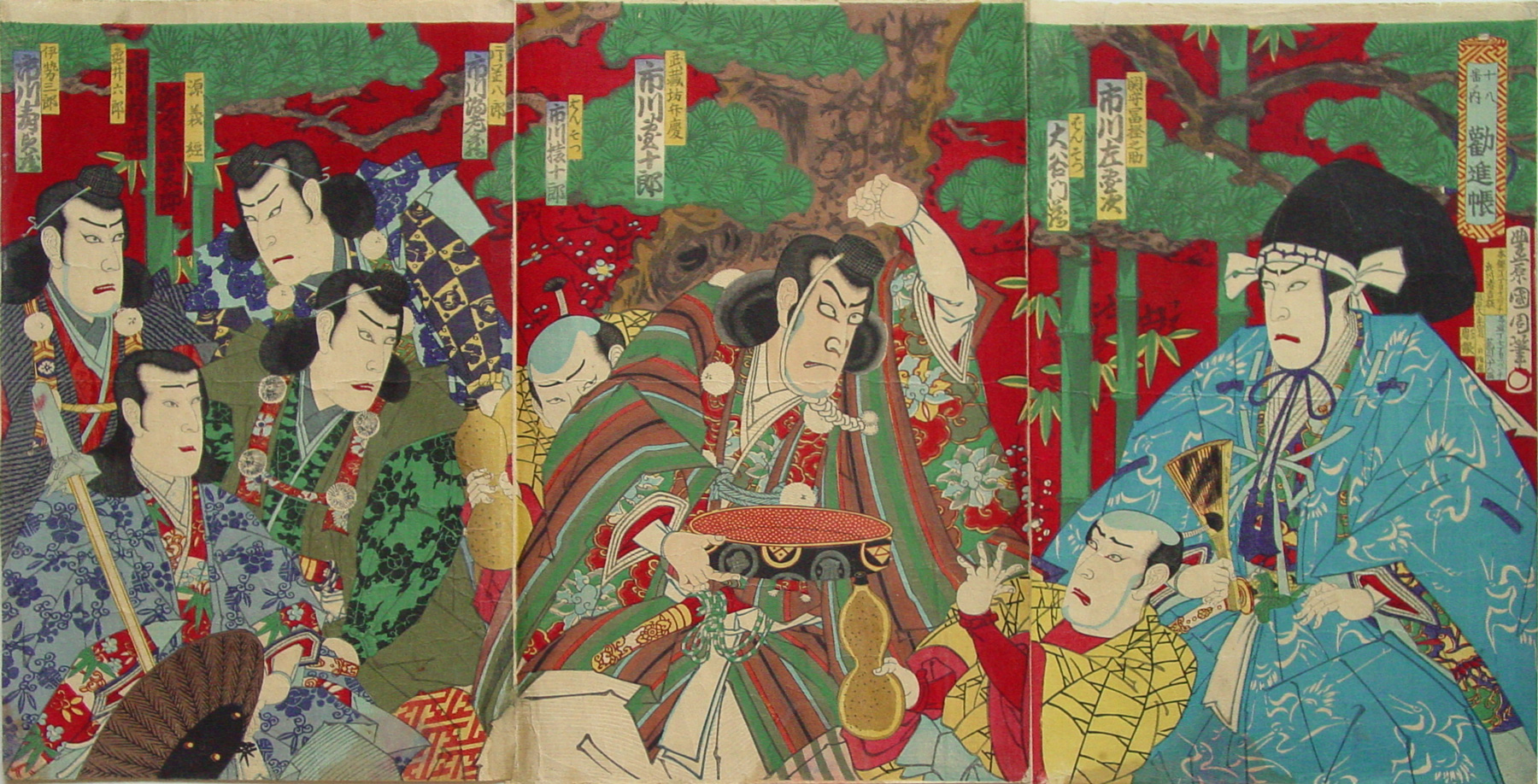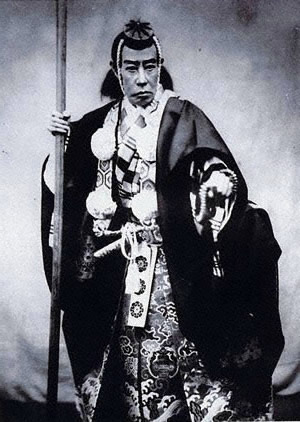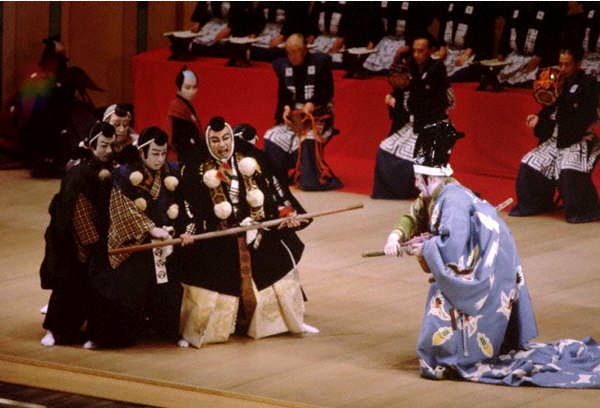About This Print
Eight actors are depicted in the play The Subscription List* (Kanjinchō), one of the masterpieces of kabuki. Ichikawa Sadanji I is the actor on the far right playing the role of Togachi Saemon, Ichikawa Danjûrô IX is the actor with arm raised in the center playing the role of Benkei and Ichikawa Ebijûrô V (not confirmed) is shown playing the role of Yoshitune in the lower left of the left panel. The other actors are unread. For another print of this play by Toyohara Kunichika (1835–1900) see IHL Cat. #398.* sometimes translated as The Contributor's List or The Subscription Record
The Actors Pictured
For profiles of Ichikawa Sadanji I, Ichikawa Danjûrô IX, and Ichikawa Ebijûrô V go to The Kabuki Actor.The Play "Kanjinchô"
Source: Naritaya Official Website http://www.naritaya.jp/english/show/detail.php?no=2010010220100126124934Set in the late twelfth century, the play depicts an episode from the life of the general Minamoto Yoshitsune. Accompanied by a small group of trusted retainers, he is escaping from his jealous older half-brother, the shogun Yoritomo. Yoshitsune's right-hand man is the warrior priest Benkei and it is he who suggests the retainers disguise themselves as mountain priests called yamabushi and Yoshitsune as their porter. Hearing rumours of this, Yoritomo has ordered barriers gates set up in order to stop and question all such yamabushi.
On their way north, Yoshitsune and his group reach the barrier at Ataka and are halted by the guard Togashi and his men. Hoping to pass through without incident, Benkei claims that they are collecting funds for the rebuilding of Todaiji temple which has recently burned down. He is challenged by Togashi to produce and read out the list of subscribers (the kanjincho of the play's title) that all fund raisers were bound to possess. Not having such a kanjincho, Benkei decides on the desperate measure of improvising the florid and pious exhortation from an empty scroll. While he is reading Togashi edges forward, trying to catch a glimpse of the scroll. Benkei catches him and the two of them pose dramatically with Benkei holding the scroll tight to his body so that Togashi cannot see it. Whether or not Togashi has seen the empty scroll and knows that Benkei is bluffing is one of the play's great talking points. He ends with the Fudo mie, a pose copying the iconography of the Buddhist deity Fudo-Myoo, the guardian protector of the yamabushi.
Still dubious, Togashi interrogates Benkei about the complicated symbolism of the yamabushi costume and this fierce verbal exchange, called the yamabushi mondo, famous for its escalating pace and tension, is another highlight of the play. Benkei concludes with the defiant Genroku mie pose.
Benkei's knowledge is impressive and Togashi decides to allow them to pass. One of his soldiers, however, points out the figure of the porter who, they claim, resembles Yoshitsune. To allay their suspicions, Benkei is forced to beat Yoshitsune with his staff as though punishing the porter for lagging behind and drawing attention to himself. Togashi is now certain that this group is indeed Yoshitsune and his men but, deeply impressed by Benkei's desperate act of loyalty, he decides to allow them through the barrier, even though he knows he must pay for this later with his own life.
Having passed safely and now a short distance from the barrier, Yoshitsune resumes his rightful position as lord of his group. As beating one's lord was an act of grave disloyalty Benkei sheds tears for the first time in his life, but Yoshitsune forgives him in a moving display of affection between lord and retainer.
Suddenly Togashi reappears. Claiming to feel sorry that he treated them so badly at the barrier, he offers Benkei some sake which is eagerly accepted. After drinking copious amounts, Benkei entertains them with the ennen no mai – the "dance of longevity." While the lyrics tell of an ideal landscape where the power of nature eternally reigns, the dance begins with slow, circular movements and gradually increasing in speed and excitement. During the dance, Benkei takes his chance and discreetly signals for his group to leave. They hasten on their way as Benkei concludes his dance. Benkei bids Togashi a moving farewell and the curtain is closed. Alone on the hanamichi, Benkei feels relieved and elated. He then joyfully bounds off to catch his master in the famous dramatic and stylized "flying exit" known as the tobi roppo.
The principal characters are:1
Togashi - barrier keeper
Yoshitune - younger brother of the shogun Yoritomo and disguised as a porter
Benkei - warrior priest and Yoshtune's loyal follower and inseparable companion, disguised as the leader of a band of yamabushi
Kamei, Kataoka, Suruga and Hitachibo: Retainers of Yoshitune, also disguised as yamabushi
Gunnai, Gennai and Heinai - soldiers of Togashi
1 The Kabuki Theatre of Japan, A. C. Scott, George Allen & Unwin Ltd,1955, p. 244.
(1985) April, Kabukiza Theater
©Nihonhaiyukyokai/Aoki Shinji
©Nihonhaiyukyokai/Aoki Shinji
Print Details
| IHL Catalog | #403 |
| Title (Description) | The Subscription List (Kanjinchō 勧進帳). |
| Artist | Toyohara Kunichika (1835–1900) |
| Signature | Toyohara Kunichika hitsu with toshidama seal |
| Seal | none |
| Publication Date |  |
| Publisher |  [Marks: similar to seal 26-081 but different address; publisher ref. 459] Bottom: 荒川八十八 画 (Arakawa Yasohachi ga) preceded by his address. |
| Carver |  |
| Impression | excellent |
| Colors | excellent |
| Condition | fair- full-size, unbacked but three sheets joined, light wrinkling, light soiling and staining along bottom margin, horizontal fold through middle of prints |
| Genre | ukiyo-e; nigao-e; yakusha-e |
| Miscellaneous | |
| Format | vertical oban triptych |
| H x W Paper | 14 1/2 x 23 3/8 in. (36.8 x 59.4 cm) |
| Literature | |
| Collections This Print |




